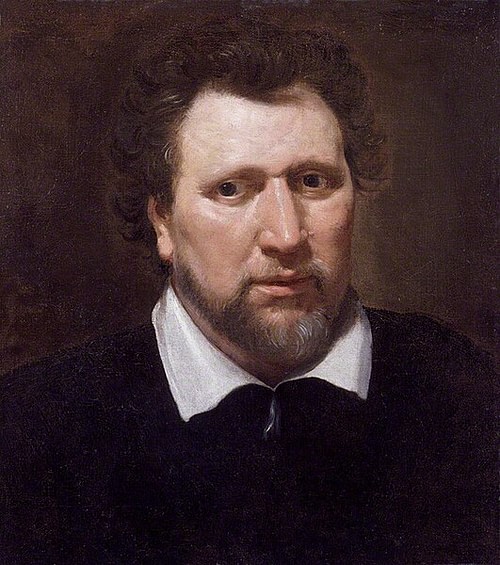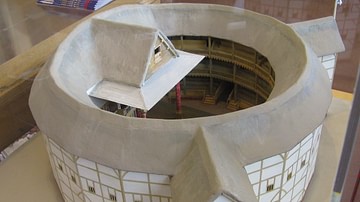
Ben Jonson (1572-1637) was an English poet, playwright, and literary critic, whose influence on English Renaissance literature during the Jacobean Era (1603-1625) has been regarded as second only to that of William Shakespeare (1564-1616). A prolific writer, Jonson penned hundreds of poems, multiple masques, as well as several major plays, mostly comedies. The most significant of his plays include Every Man in His Humour (1598), Volpone, or the Fox (1606), Epicoene, or the Silent Woman (1609), The Alchemist (1610), and Bartholomew Fair (1614).
Early Life & Adventures
In 1618, a middle-aged Ben Jonson embarked on a walking tour from London to Scotland and back again. While staying in Edinburgh, he lived for two weeks with Scottish poet William Drummond of Hawthornden. The two clearly enjoyed one another's company, speaking freely on topics ranging from their own personal lives to gossip about the London literary scene, and even discussing their opinions on the king. Drummond was so fascinated by his guest that he took extensive notes of their talks – recording only Jonson's side of the conversation – and grouped them by topic. It is largely from Drummond's notes that scholars have been able to surmise the details of Jonson's personal life.

Benjamin Jonson was born on 11 June 1572, in or around the city of London. His father, a Protestant, had lost his lands and had been imprisoned as part of the religious persecutions that took place under the Catholic Queen Mary I of England (r. 1553-1558). Though these persecutions ended after the accession of Mary's sister, the Protestant Queen Elizabeth I of England (r. 1558-1603), the elder Jonson never recovered his fortunes and died about a month before his son's birth. Two years later, Jonson's mother was remarried to a successful bricklayer, who went on to become Master of the Tilers' and Bricklayers' Company. As a boy, Jonson showed a knack for academics and, with the financial support of a benefactor, was sent to be educated at Westminster School, one of the most fashionable in the country. He was personally tutored by the renowned antiquarian William Camden, under whose guidance he excelled in his classical and grammatical studies.
Upon graduating from Westminster in 1589, Jonson was briefly enrolled at St. John's College, Cambridge, but his studies were cut short when his stepfather called him home to begin an apprenticeship as a bricklayer. This life did not suit Jonson, who soon volunteered for the English army and was sent to fight the Spanish in the Low Countries. Jonson would later boast that, during his military service, he killed an enemy soldier in single combat and took the optima spolia, meaning he stripped the armor and weapons off his defeated foe as a prize. By 1592, Jonson had returned to England and eventually found work as an actor in the Admiral's Men, a company that performed at The Rose theatre – there is evidence that he played the role of Hieronimo, the lead in Thomas Kyd's popular revenge play, The Spanish Tragedy.
During this time, Jonson turned into something of a womanizer. In his conversations with Drummond, he admits that had had often been 'given to venery' as a young man and recounts several of his sexual exploits. In one instance, he was seduced by a married woman at the behest of her husband, who was "passingly delighted" by their affair. In another, Jonson courted a woman who "showed him all that he wished" of her body, but refused to go as far as "the last act" (quoted in Wells, 131). But though he believed the "use of a maid nothing in comparison to the wantonness of a wife", Jonson finally settled down and married Anne Lewis in 1594. Their marriage was – perhaps unsurprisingly – a rocky one, and they spent several years living apart before reconciling for good in 1605. They had at least four children, all of whom Jonson would tragically outlive.
Career Beginnings
Whatever his acting talents, by 1597, Jonson was clearly more valued as a writer. Philip Henslowe, the leading impresario of public theatre in London, frequently contracted him to write 'get-penny' entertainments – these were plays that were written quickly and with financial profit in mind. Playwrights like Jonson were expected to write these plays, from outline to final product, in a matter of weeks – in his diary, Henslowe records that he advanced Jonson £1 in early December to write a play that was expected to be performed at Christmas. Jonson's first known play, The Case is Altered, was written for Henslowe in the early part of 1597. Based on two plays by the Roman dramatist Plautus, this comedy contains "the most grossly scatological scene in all of Elizabethan drama", where an old miser named Jaques (a pun on the word 'jakes', or toilet) hides gold in a pile of dung before asking "who will suppose that such a precious nest / is crowned with such a dunghill excrement?" (David Riggs, quoted in Wells 133). Such humor was common to Jonson's comedies.
That same year, Jonson collaborated with fellow playwright Thomas Nashe to pen the controversial play Isle of Dogs. The play is now lost but appears to have been a political satire about the Elizabethan court – the 'Isle of Dogs' was a strip of land across from Greenwich, where Queen Elizabeth I often held court. The first performance of the play caused a major scandal and was condemned by authorities as containing "very seditious and slanderous matter" (quoted in Wells, 133). Fearing arrest, Nashe fled the city, but Jonson was unable to leave in time – he, along with two of the play's lead actors, were arrested and jailed for six weeks. The queen's Privy Council responded with force, forbidding any plays to be performed in London in the summer of 1597 and ordering that "those playhouses that are erected and built only for such purposes shall be plucked down" (quoted in Wells, 134). Fortunately for Jonson – and indeed for English literature – this edict was not enforced, and plays continued to be performed.
Jonson got into more trouble the following year, when he killed an actor, Gabriel Spenser, in a duel. Spenser had been one of the actors imprisoned with Jonson for the Isle of Dogs fiasco, and, while the reason for their dispute is unknown, it got bad enough for Spenser to challenge Jonson to a duel in September 1598. Jonson would later tell Drummond that Spenser had a sword ten inches longer than his and was able to wound him in the arm, but Jonson ultimately got the better of his opponent and killed him. For this, he was arrested, imprisoned, and condemned to death. But the cunning Jonson avoided this fate by claiming 'benefit of clergy', a legal loophole that granted leniency to any condemned man who could prove that he was literate by reciting a Bible verse in Latin. Although he escaped death, Jonson's thumb was branded with a 'T', meaning that if he were arrested for a similar crime, he would be hanged at Tyburn, the place of public execution.

Despite this narrow brush with death, Jonson continued to write. In 1598, he wrote Every Man in His Humour, a play that popularized the 'comedy of humours' genre of dramatic comedy – this genre usually features a set of characters, each of whom has a dominant trait, or 'humour', that controls their actions. According to Nicholas Rowe, an 18th-century Shakespeare biographer, Jonson had initially taken this play to be performed by the Lord Chamberlain's Men, the acting company with whom Shakespeare wrote. The company was on the verge of rejecting the play when Shakespeare himself intervened; he "cast his eye upon it and found something so well in it as to engage him first to read it through, and afterwards to recommend Mr. Jonson and his writings to the public" (quoted in Wells, 135). Rowe insists that after this moment, Shakespeare and Jonson were "professed friends" – if this was true, then professional jealousy sometimes invaded their friendship, as Jonson was known to be critical of Shakespeare's work. Nevertheless, Shakespeare is said to have acted in this production, and the Chamberlain's Men staged Jonson's follow-up play Every Man Out of His Humour the following year. This comedy, one of the longest plays written for public Elizabethan theatre, did not live up to the popularity of its precursor.
Peak Years
In 1601, Jonson became embroiled in a public feud with playwrights John Marston and Thomas Dekker, afterwards known as the 'War of the Theatres.' After Marston included an unflattering reference to Jonson in one of his plays, Jonson retaliated by mocking Marston and Dekker in his plays Cynthia's Revels and Poetaster (both 1601). In 1602, Marston and Dekker teamed up to write Satiromastix, Or the Untrussing of the Humourous Poet, in which they further lambast Jonson. This feud continued for a while and may have turned physical; Jonson would later confess to Drummond that he "had many quarrels with Marston, beat him, and took his pistol from him". But considering Jonson would later collaborate with Marston, some scholars suspect that the 'War of the Theatres' was little more than a publicity stunt to increase the three playwrights' profiles.
In 1603, Queen Elizabeth died, and King James I of England (r. 1603-1625) ascended the throne. Hoping to win favor with the new monarch, Jonson turned to writing masques – this refers to a form of courtly entertainment involving singing, dancing, and acting. The first of his masques, The Entertainment at Athorp, was performed before the new queen in 1603 as she journeyed down from Scotland, while another, The Masque of Blackness, was put on before the royal court itself in 1605. But even as he courted the king's favor, Jonson could not help courting some trouble as well – in 1605, he collaborated with George Chapman and John Marston to write Eastward Ho, which contains several jokes at the king's expense. For this offense, Jonson, Chapman, and Marston were imprisoned and threatened with having their ears and noses slit. By this point, however, Jonson had accumulated several influential patrons, who were able to successfully intervene on his behalf, and the three playwrights were released. The following year, Jonson was made to appear before the consistory court in London to explain his lack of participation in the Anglican Church. In the wake of the Gunpowder Plot of 1605, this could have been serious, especially since Jonson had secretly been Catholic for the previous twelve years. But Jonson managed to talk his way to a lesser punishment and was only fined 13 shillings.
Despite these hiccups, Jonson continued to win favor at court, writing multiple masques for the duration of King James' reign. Since masques required elaborate set pieces, he often worked with the illustrious architect and theatrical designer Inigo Jones – their working relationship, though productive, was also quite stormy. The Jacobean Era also seems to have been the most successful period of Jonson's playwrighting career; during an eight-year span, he wrote his best comedies, including Volpone (1606), The Silent Woman (1609), The Alchemist (1610), and Bartholomew Fair (1614). Each of these works examines some aspect of human vice, always exaggerated for comedic effect; Volpone, for example, satirizes greed and lust, with the characters named after animals. These comedies were well-received both in Jonson's own lifetime and in the decades after his death, renowned for their witty dialogue, excellent use of characterization, and tight plots. Less successful were his Roman history plays, Sejanus, His Fall (1603) and Catiline, His Conspiracy (1611), which were considered too pedantic – the actors in the first performance of Sejanus were apparently booed offstage by the audience of the Globe Theatre in 1603.
As he grew older, Jonson evidently grew concerned with his legacy. In 1616, he compiled his plays into a folio entitled The Works of Benjamin Jonson, in which his works were presented as if they were ancient classics. In the process of publishing this volume, Jonson made edits to his plays and entirely excluded some manuscripts that were not up to his current standard. Therefore, Jonson became the first English playwright to publish a collection of his own works in his lifetime (for comparison, the first official collection of Shakespeare's works was not published until 1623, seven years after his death). That same year, Jonson was granted a royal pension in recognition of his literary accomplishments, effectively making him England's first poet laureate. So, when Jonson made his walking tour to Scotland in 1618 and had his conversations with Drummond, he was at the peak of his career, a virtual celebrity playwright.

Later Years & Legacy
After the publication of his folio, Jonson returned to writing plays. His comedy The Devil is an Ass was performed in 1617 by the King's Men (as the Chamberlain's Men were now known), though it was often considered of lesser quality to Jonson's earlier work. Indeed, his later plays of the 1620s and '30s – including The Staple of News (1626), The New Inn (1629), and A Tale of a Tub (1633) – were generally not well-received and were dismissed by literary critic John Dryden as 'dotages'. Jonson continued to write masques for the Jacobean court, the last of which was written for the Twelfth Night celebrations of 1625. But after the accession of King Charles I of England (r. 1625-1649), Jonson's favorability at the royal court declined, and he was called on less and less to write new masques. Jonson's personal life was plagued by misfortune during this era as well. In 1623, his library was destroyed in a fire, and in 1628, he suffered a series of strokes that rendered him bedridden. He was granted a new royal pension in 1634, but by then, he was effectively retired. He died on 6 August 1637 at the age of 65, with two unfinished plays discovered amongst his papers. He was buried - most unusually - in the upright position at Westminster Abbey, his monument inscribed with the words 'O rare Ben Jonson'.
Immediately upon his death, Jonson was recognized as one of the most important dramatists of the last 40 years. He had inspired a new generation of dramatists – who called themselves the Sons of Ben – and his plays continued to be performed with regularity. In 1640, a second, revised folio of Jonson's complete works was posthumously published, which included a series of notes he had written entitled Timber, or Discoveries. Here, Jonson records some of his thoughts on Shakespeare, famously writing "I remember the players have often mentioned it as an honour to Shakespeare that in his writing he never blotted a line. My answer hath been, 'Would he had blotted a thousand'" (quoted in Wells, 161). But despite this critique, Jonson goes on to say that, "I loved that man, and do honour his memory – on this side of idolatry – as much as any" (ibid).
It was Jonson, of course, who said that Shakespeare was "not of an age, but for all time", a statement that would prove all too true, to the detriment of Jonson's own legacy. In the decades immediately after Jonson's death, his work was held in equal regard to Shakespeare's; but as time wore on, Jonson's style of satirical comedy fell out of fashion, while the timelessness of Shakespeare's own works ensured that they were being constantly performed and reinterpreted. Though Jonson has been overshadowed by Shakespeare since the 19th century, his influence should not be understated – after all, Jonson wrote many successful plays and poems, influencing such writers as John Milton and Jonathan Swift. As scholar Stanley Wells puts it, Jonson remains "both one of the most fascinatingly complex characters and the most complete men of letters in the whole of British literature" (166).







